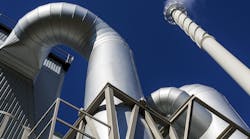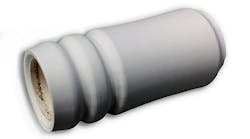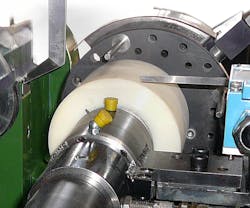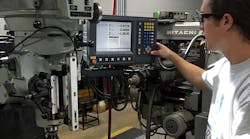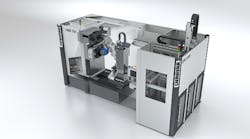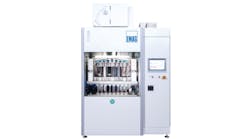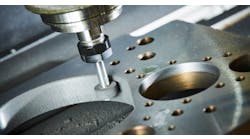Internal combustion engine-powered generators fueled by natural gas are steadily growing gaining importance for manufacturers and electric utilities, both domestically and abroad, as they employ on-site power production machinery that is efficient and more environmentally friendly than comparable sources of electricity, coal-based power plants for example.
Natural gas can generate electricity in different ways; the most basic is through a natural gas-fired/electric generating (cogeneration) plant, where a steam-generating unit burns fossil fuels (natural gas) to heat water, which produces steam powering turbines to generate electricity.
In their own pursuit of greater efficiency, engine manufacturers now are building natural gas engine-powered generators that feature “lean-burn” technology. Excess air is introduced into the engine in concert with the fuel. The excess air reduces the combustion temperature, and during this process, the amount of oxides of nitrogen or NOx produced is cut in half, compared to a conventional natural gas engine – therefore the engine burns “lean”.
Answer: Spark Plugs — In these types of engines, a spark plug (a very large one) is vital to the performance of a function occurring in the combustion process. In a lean burning engine, pre-mixing of air and fuel occur before entering the cylinder head where the spark plug is located. To prevent knocking or misfiring, the combustion process taking place in the chamber must be controlled within a narrow operating window.
Vital to the configuration of any spark plug is the proper manufacturing of the ceramic insulator body component. Likewise, large spark plugs require these ceramic insulators to make them function properly. Spark plugs are exposed to over 40,000 volts during ignition. They need sufficient insulation capability as temperatures in excess of 1,000 degrees centigrade is crucial. They also need to be pressure and gas tight in the combustion chamber and withstand pressures over 1,500 psi with vibration in an engine.
The ceramic blanks are pressed into a mold, then ground to shape and fired to produce the spark plug used in engines. The concentricity and shape of the ceramic insulator is critical to meet those daunting requirements.
The Ferris Wheel Grinding Process — The raw ceramic portion of the spark plug usually has a hole in its center where the earthing electrode components are installed, and therefore requires a concentric type of OD grinding machine for precision processing.
Glebar’s FW-9D Ferris Wheel concentric (OD) grinding machine is the right fit for this component for a variety of reasons. The insulator bodies found in these types of engines are much larger than traditional spark plugs (found in commercial automobiles for example). The manufacturing cost for retooling a high production line is normally reserved for high volume standard plug sizes for smaller engines. Glebar’s machine could be simply configured for a longer part and larger part, capable of shaping a pre-fired ceramic blank up to 8 in. long.
The insulator body is first fitted onto precision arbors mounted on a carrier plate. The plate, driven by a servo motor, places the part in contact with the shaped grinding wheel producing components concentric to the inside diameter. This motion is controlled to prevent the blanks, which have the consistency of chalk, from breaking during the grind cycle.
In a recent example, a manufacturer of insulators required the ability to grind four diameters as well as multiple compound angles and for radii to be ground concentric to the part ID within 0.003 in. Before finding Glebar’s grinding approach, this manufacturer was shaping these insulators on machines tooled to run high volumes of parts in an inefficient way to fabricate low volume batches of large insulators. Also, dressing the profile in the grinding wheel was not as versatile as a Glebar where a grinding wheel change takes 15 minutes and the wheel shape can be performed directly on the machine.
Advancing Plunge Grinding — The FW-9D Ferris Wheel / OD Grinder, designed by Glebar, offers a novel version of plunge grinding wherein the outside shape of the product is ground relative to the center of the part. Engineers originally developed the process for finishing rubber capstans and it has since been advanced for grinding precision bushings, ceramic components, such as the spark plugs used in the cogeneration plant application.
The FW-9D’s unique grinding technique solves the concentricity problem faced by conventional centerless grinding machines. It also allows the machine to have parts staged during a grind Because of this unique method, the insulator manufacturer chose the FW-9D as their machine, and was ultimately able to produce a finish ground part every twelve seconds concentric to the ID within .001.
In addition, the process of redressing the grinding wheel is simplified by using a contour dressing attachment which allows the wheel to be dressed with a multitude of profile shapes very simply on the machine.
The ability to reconfigure the grinding wheel geometry in concert with the finished ceramic insulator rapidly makes the machine FW-9D a versatile option for these short run, high value plugs, -- an example of product development where a design can be prototyped effectively and efficiently, reducing tooling costs and time to market for these large specialty plugs.
Vito Barbiera is the Communications Manager for Glebar Co., a developer and manufacturer of centerless grinding technologies. Contact him at [email protected]; or visit www.glebar.com
